Griffiths D. Head First Statistics
Подождите немного. Документ загружается.


you are here 4 621
correlation and regression
The SSE reminds me of the variance.
The variance uses squared distances from
the mean, and the SSE uses squared
distances from the line.
The variance and SSE are calculated in similar ways.
The SSE isn’t the variance, but it does deal with the distance squared between
two particular points. It gives the total of the distances squared between the
actual value of y and what we predict the value of y to be, based on the line
of best fit.
What we need to do now is use the data to find the values of a and b that
minimize the SSE, based on the line y = a + bx.
Introducing the sum of squared errors
Can you remember when we first derived the variance? We wanted to look
at the total distance between sets of values and the mean, but the total
distances cancelled each other out. To get around this, we added together
all the distances squared instead to ensure that all values were positive.
We have a similar situation here. Instead of looking at the total distance
between the actual and expected points, we need to add together the
distances squared. That way, we make sure that all the values are positive.
The total sum of the distances squared is called the sum of squared
errors, or SSE. It’s given by:
SSE = Σ(y - y)
2
The difference between the real values
of y, and what we predict from the
line of best fit
The sum of squared errors
In other words, we take each value of y, subtract the predicted value of y
from the line of best fit, square it, and then add all the results together.
^
y
i
is the actual value.
y
i
is the value we
estimate it to be
from the line.
^
x
y
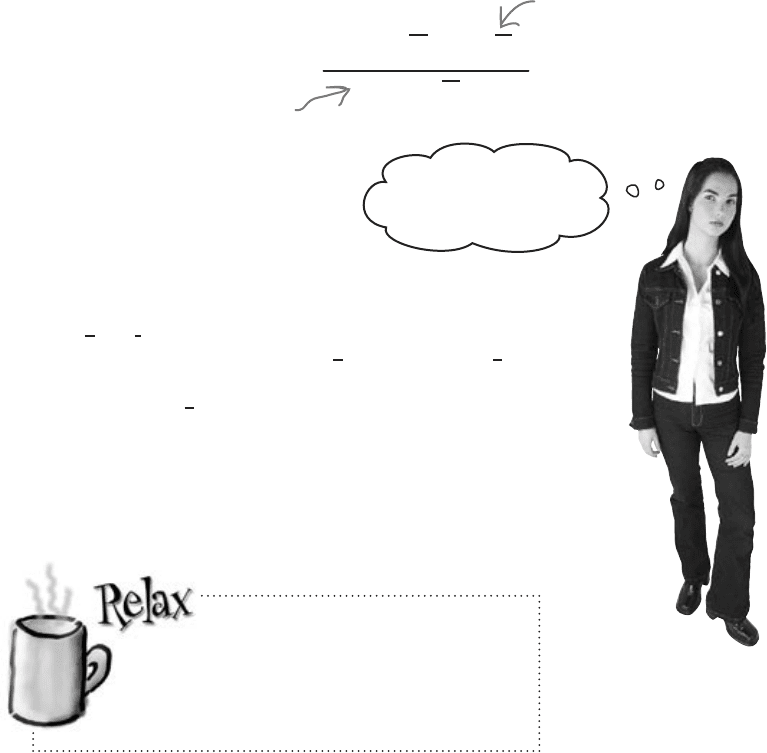
622 Chapter 15
Let’s start with b
The value of b for the line y = a + bx gives us the slope, or steepness, of
the line. In other words, b is the slope for the line of best fit.
We’re not going to show you the proof for this, but the value of b that
minimizes the SSE Σ(y - y)
2
is given by
b = Σ((x - x)(y - y))
Σ(x - x)
2
Find the equation for the line of best fit
We’ve said that we want to minimize the sum of squared errors, Σ(y - y)
2
,
where y = a + bx. By doing this, we’ll be able to find optimal values for a
and b, and that will give us the equation for the line of best fit.
Are you sure? That
looks complicated.
The calculation looks tricky at first, but it’s not that
difficult with practice.
First of all, find x and y, the means of the x and y values for the data that
you have. Once you’ve done that, calculate (x - x) multiplied by (y - y) for
every observation in your data set, and add the results together. Finally,
divide the whole lot by Σ(x - x)
2
. This last part of the equation is very
similar to how you calculate the variance of a sample. The only difference
is that you don’t divide by (n - 1). You can also get software packages that
work all of this out for you.
Let’s take a look at how you use this in practice.
^
^
Each value of x, minus the mean of the
x values, multiplied by the corresponding
value of y, minus the mean of the y values
This bit’s similar to how you find the
variance of x. For each value of x,
subtract the mean of the x values and
square the result.
If you need to calculate this in
an exam, you will almost
certainly be given the formula.
This means that you won’t have to memorize
the formula, just know how to use it.
calculating b for the line of best fit

you are here 4 623
correlation and regression
Let’s see if we can use this to find the slope of the line y = a + bx for
the concert data. First of all, here’s a reminder of the data:
x (sunshine)
1.9 2.5 3.2 3.8 4.7 5.5 5.9 7.2
y (attendance)
22 33 30 42 38 49 42 55
Let’s start by finding the values of x and y, the sample means of the x
and y values. We calculate these in exactly the same way as before, so
x = (1.9 + 2.5 + 3.2 + 3.8 + 4.7 + 5.5 + 5.9 + 7.2)/8
= 34.7/8
= 4.3375
y = (22 + 33 + 30 + 42 + 38 + 49 + 42 + 55)/8
= 311/8
= 38.875
Now that we’ve found x and y, we can use them to help us find the
value of b using the formula on the opposite page.
We use x and y to help us find b
The first part of the formula is Σ(x - x)(y - y). To find this, we take the x
and y values for each observation, subtract x from the x value, subtract
y from the y value, and then multiply the two together. Once we’ve
done this for every observation, we then add the whole lot up together.
Use the values of x to find x,
and the values of y to find y.
Σ(x - x)(y - y) = (1.9 - 4.3375)(22 - 38.75) + (2.5 - 4.3375)(33 - 38.75) + (3.2 - 4.3375)(30 - 38.75) +
(3.8 - 4.3375)(42 - 38.75) + (4.7 - 4.3375)(38 - 38.75) + (5.5 - 4.3375)(49 - 38.75) +
(5.9 - 4.3375)(42 - 38.75) + (7.2 - 4.3375)(55 - 38.75)
= (-2.4375)(-16.75) + (-1.8375)(-5.875) + (-1.1375)(-8.875) + (-0.5375)(3.125) + (0.3625)(-0.875) +
(1.1625)(10.125) + (1.5625)(3.125) + (2.8625)(16.125)
= 40.828125 + 10.7953125 + 10.0953125 -1.6796875 -0.3171875 + 11.7703125 + 4.8828125 +
46.1578125
= 122.53 (to 2 decimal places)
x - x
y - y
(x - x)(y - y)
Add these together for
every set of values.
Finding the slope for the line of best fit
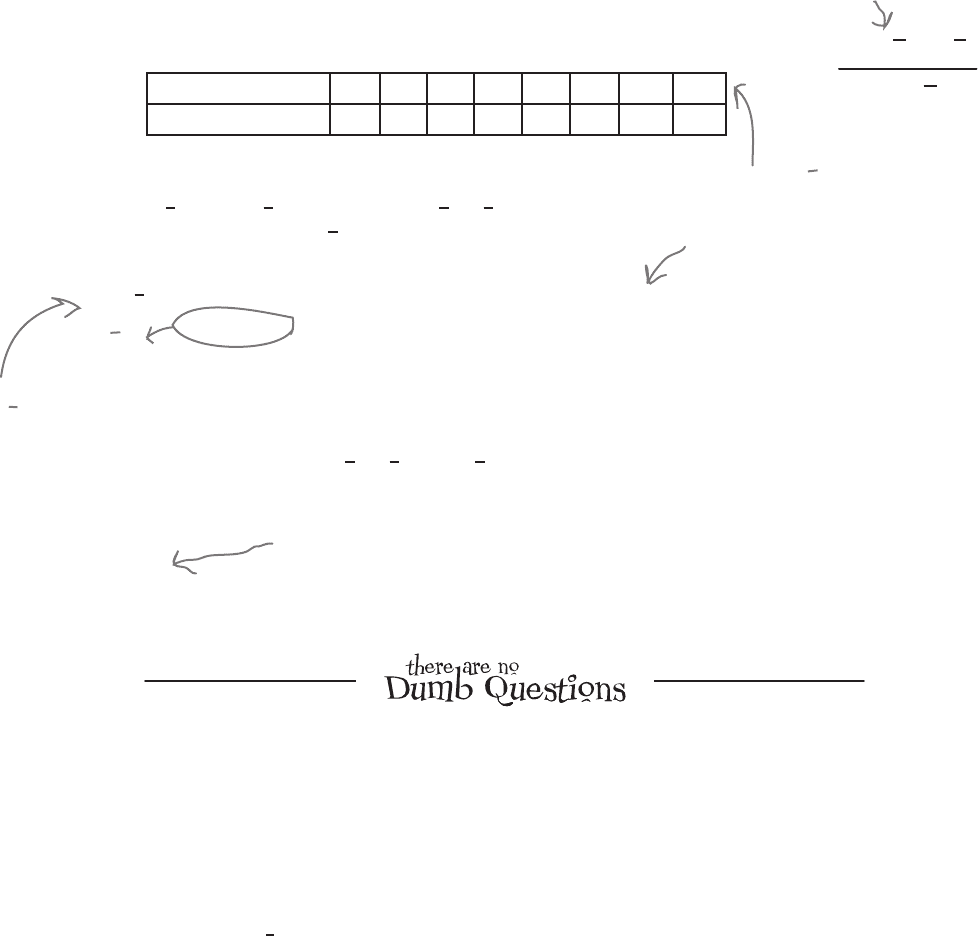
624 Chapter 15
Σ(x - x)
2
= (1.9 - 4.3375)
2
+ (2.5 - 4.3375)
2
+ (3.2 - 4.3375)
2
+ (3.8 - 4.3375)
2
+ (4.7 - 4.3375)
2
+ (5.5 - 4.3375)
2
+
(5.9 - 4.3375)
2
+ (7.2 - 4.3375)
2
= (-2.4375)
2
+ (-1.8375)
2
+ (-1.1375)
2
+ (-0.5375)
2
+ (0.3625)
2
+ (1.1625)
2
+ (1.5625)
2
+ (2.8625)
2
= 23.02 (to 2 decimal places)
We find the value of b by dividing Σ(x - x)(y - y) by Σ(x - x)
2
. This gives us
b = 122.53/23.02
= 5.32
Finding the slope for the line of best fit, part ii
Here’s a reminder of the data for concert attendance and predicted hours of sunshine:
We’re part of the way through calculating the value of b, where y = a + bx.
We’ve found that x = 4.3375, y = 38.875, and Σ(x - x)(y - y) = 122.53. The
final thing we have left to find is Σ(x - x)
2
. Let’s give it a go
x (sunshine)
1.9 2.5 3.2 3.8 4.7 5.5 5.9 7.2
y (attendance)
22 33 30 42 38 49 42 55
We find Σ(x - x)
2
using the
x values. It’s a bit like finding
the variance of a sample, but
without dividing by n-1.
In other words, the line of best fit for the data is y = a + 5.32x. But what’s a?
Q:
It looks like the formulas you’ve
given are for samples rather than
populations. Is that right?
A: That’s right. We’ve used samples
rather than populations because the data
we’ve been given is a sample. There’s
nothing to stop you using a population if you
have the data, just use μ instead of x.
Q:
Is the value of b always positive?
A: No, it isn’t. Whether b is positive
or negative actually depends on the type
of linear correlation. For positive linear
correlation, b is positive. For negative linear
correlation, b is negative.
Q:
I’ve heard of the term gradient.
What’s that?
A: Gradient is another term for the slope
of the line, b.
Q:
What about if there’s no
correlation? Can I still work out b?
A: If there’s no correlation, you can still
technically find a line of best fit, but it won’t
be an effective model of the data, and you
won’t be able to make accurate predictions
using it.
Q:
Is there an easy way of calculating
b?
A: Calculating b is tricky if you have lots
of observations, but you can get software
packages to calculate this for you.
b = Σ(x - x)(y - y)
Σ(x - x)
2
Here’s a reminder
of the formula.
We’ve found b. This gives the slope
for the line of best fit.
calculating b for the line of best fit, part deux
(x - x)
2
Note, we don’t use y
or y in this part of
the equation.
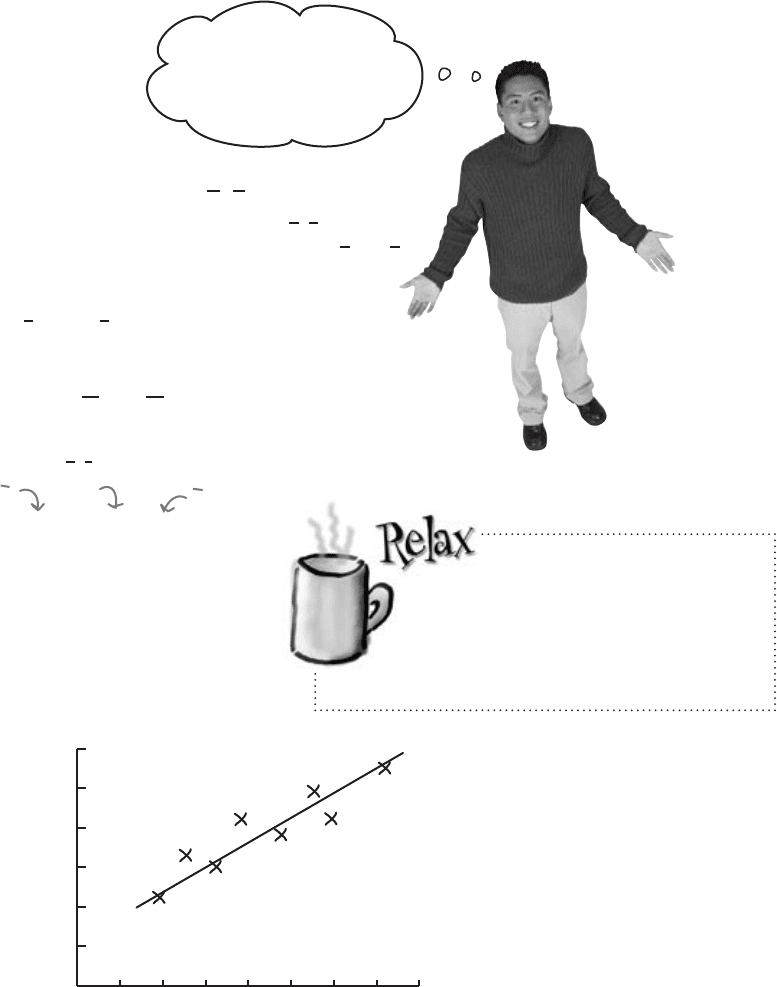
you are here 4 625
correlation and regression
We’ve found b, but what about a?
So far we’ve found what the optimal value of b is for the line of best fit
y = a + bx. What we don’t know yet is the value of a.
I’m sure we’d be able
to find a if we knew
one of the points it
should go through.
The line needs to go through point (x, y).
It’s good for the line of best fit to go through the the point (x, y), the
means of x and y. We can make sure this happens by substituting x and y
into the equation for the line y = a + bx. This gives us
y = a + bx
or
a = y - bx
b = Σ(x - x)(y - y)
Σ(x - x)
2
We’ve already found values for x, y, and b. Substituting in these values
gives us
a = 38.875 – 5.32(4.3375)
= 38.875 – 23.0755
= 15.80 (to 2 decimal places)
This means that the line of best fit is given by
y = 15.80 + 5.32x
If you’re taking a statistics
exam, it’s likely you’ll be
given this formula.
This means that you’re unlikely to have to
memorize it, you just need to know how
to use it.
sunshine (hours)
attendance (100’s)
0 1 2 3 4 5 6 7 8
0
10
20
30
40
50
60
x
y
y = 15.80 + 5.32x
x
y
b
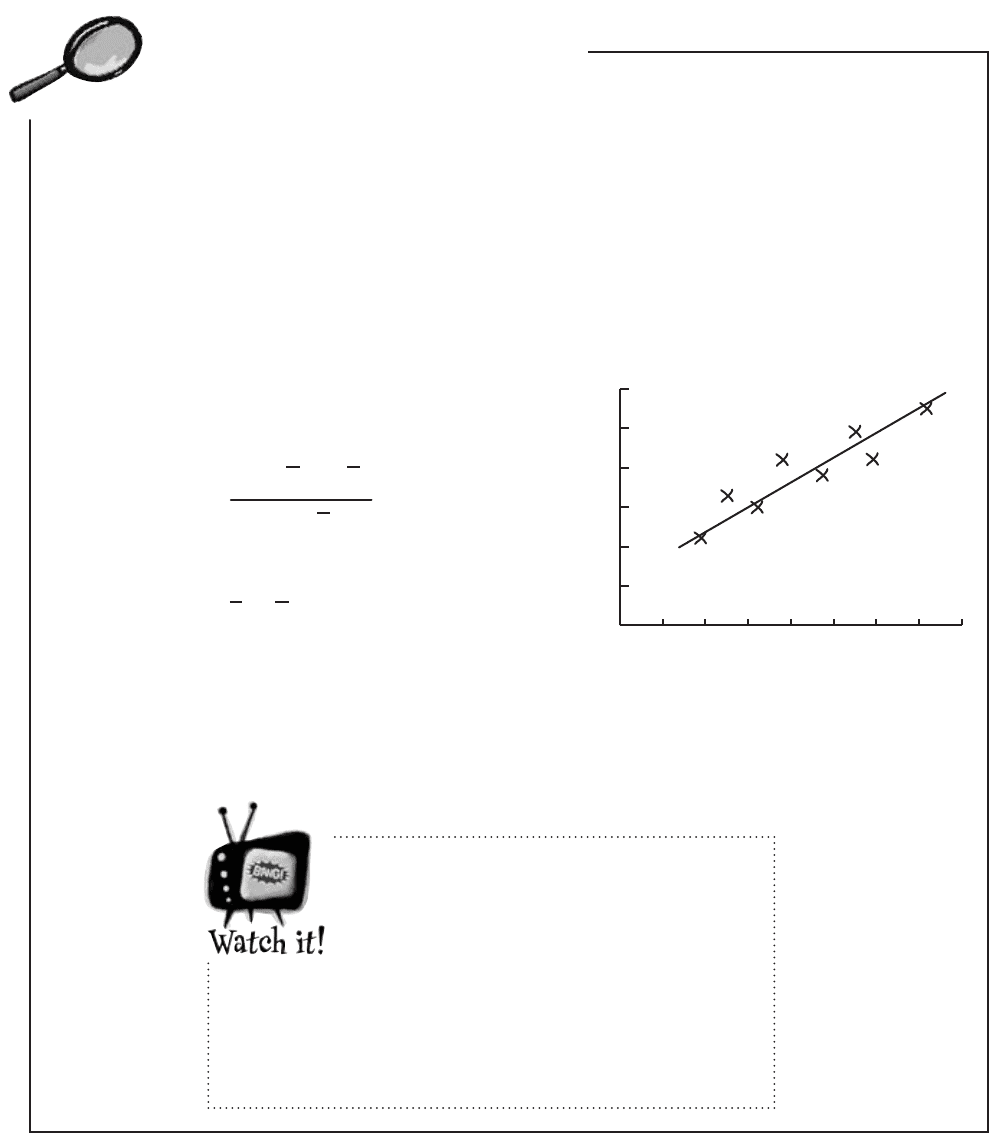
626 Chapter 15
Least Squares Regression Up Close
The mathematical method we’ve been using to find the line of best
fit is called least squares regression.
Least squares regression is a mathematical way of fitting a line
of best fit to a set of bivariate data. It’s a way of fitting a line y = a +
bx to a set of values so that the sum of squared errors is minimized—
in other words, so that the distance between the actual values and
their estimates are minimized. The sum of squared errors is given by
To perform least squares regression on a set of data, you need
to find the values of a and b that best fit the data points to the
line y = a + bx and minimizes the SSE. You can do this using:
a = y - bx
and
b = Σ(x - x)(y - y)
Σ(x - x)
2
Once you’ve found the line of best fit, y = a + bx, you can use it
to predict the value of y, given a value b. To do this, just substitute
your x value into the equation y = a + bx.
The line y = a + bx is called the regression line.
When you’re predicting values of y
for a particular value of x, be wary
of predicting values that fall outside
the area you have data points for.
Linear regression is just an estimate based on the
information you have, and it shows the relationship
between the data points you know about. This doesn’t
mean that it applies well beyond the limits of the data
0 1 2 3 4 5 6 7 8
0
10
20
30
40
50
60
x
y
y = a + bx
SSE = Σ(y - y)
2
^
least squares regression in depth

you are here 4 627
correlation and regression
We’ve found an equation for the regression line, so now the
concert organizers have a couple of questions for you. As a
reminder, the regression line is given by
y = 15.80 + 5.32x
where x is the predicted hours of sunshine, and y is the concert
attendance in 100’s.
The predicted amount of sunshine on the day of the next concert is 6 hours. What do you expect concert
attendance to be?
If concert attendance looks like it’s dropping below 3,500, the concert organizers won’t make a profit and will
have to cancel the concert. What’s the corresponding number of hours of predicted sunshine?

628 Chapter 15
The predicted amount of sunshine on the day of the next concert is 6 hours. What do you expect concert
attendance to be?
If concert attendance looks like it’s dropping below 3,500, the concert organizers won’t make a profit and will
have to cancel the concert. What’s the corresponding number of hours of predicted sunshine?
We’ve found an equation for the regression line, so now the
concert organizers have a couple of questions for you. As a
reminder, the regression line is given by
y = 15.80 + 5.32x
where x is the predicted hours of sunshine, and y is the concert
attendance in 100’s.
As x is the predicted number of hours of sunshine, this means that x = 6. We need to find the
corresponding prediction for concert attendance, so this means we need to find y for this value of x.
y = 15.80 + 5.32x
= 15.80 + 5.32 x 6
= 15.80 + 31.92
= 47.72
As y is in 100s, this means that the expected concert attendance is 47.72 x 100 = 4772.
This time, we want to find the value of x for a particular value of y.
The concert attendance is 3,500, which means that y = 35. This gives us
y = 15.80 + 5.32x
35 = 15.80 + 5.32x
35 - 15.80 = 5.32x
19.2 = 5.32x
x = 19.2/5.32
= 3.61 (to 2 decimal places)
In other words, we’d predict concert attendance to be below 3,500 if the predicted hours of sunshine is
below 3.61 hours.
sharpen solution

you are here 4 629
correlation and regression
That’s awesome, dude! But just one
question. How accurate is this exactly?
Why do you think it’s important to know the strength of the correlation? What
difference do you think this would make to the concert organizers?
You’ve made the connection
So far you’ve used linear regression to model the connection between
predicted hours of sunshine and concert attendance. Once you know what
the predicted amount of sunshine is, you can predict concert attendance
using y = a + bx.
Being able to predict attendance means you’ll be able to really help the
concert organizers know what they can expect ticket sales to be, and also
what sort of profit they can reasonably expect to make from each event.
It’s the line of best fit, but we don’t know how
accurate it is.
The line y = a + bx is the best line we could have come up with, but
how accurately does it model the connection between the amount
of sunshine and the concert attendance? There’s one thing left to
consider, the strength of correlation of the regression line.
What would be really useful is if we could come up with some way of
indicating how far the points are dispersed away from the line, as that
will give an indication of how accurate we can expect our predictions
to be based on what we already know.
Let’s look at a few examples.
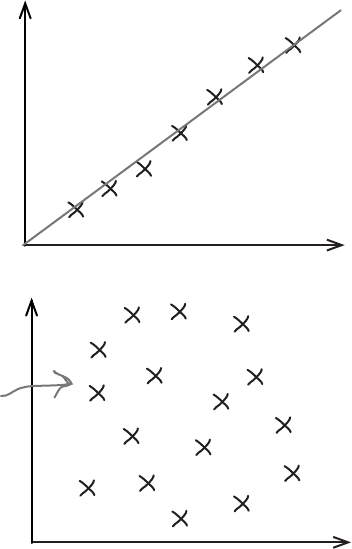
630 Chapter 15
Accurate linear correlation
For this set of data, the linear correlation is an accurate
fit of the data. The regression line isn’t 100% perfect,
but it’s very close. It’s likely that any predictions made
on the basis of it will be accurate.
Let’s look at some correlations
The line of best fit of a set of data is the best line we can come up with to
model the mathematical relationship between two variables.
Even though it’s the line that fits the data best, it’s unlikely that the line
will fit precisely through every single point. Let’s look at some different
sets of data to see how closely the line fits the data.
Can you see what the problem is?
Both sets of data have a regression line, but the actual fit of the data varies
quite a lot. For the first set of data, the correlation is very tight, but for the
second, the points are scattered too widely for the regression line to be
useful.
Least squares estimates can be used to predict values, which means they
would be helpful if there was some way of indicating how tightly the data
points fit the line, and how accurate we can expect any predictions to be
as a result.
There’s a way of calculating the fit of the line, called the correlation
coefficient.
No linear correlation
For this set of data, there is no linear correlation. It’s
possible to calculate a regression line using least squares
regression, but any predictions made are unlikely to be
accurate.
Where would we
draw the line?
types of correlations
